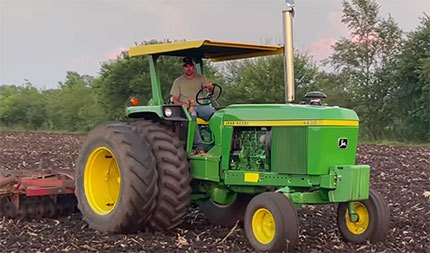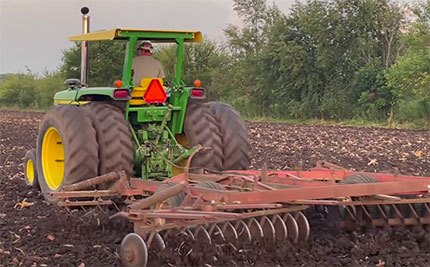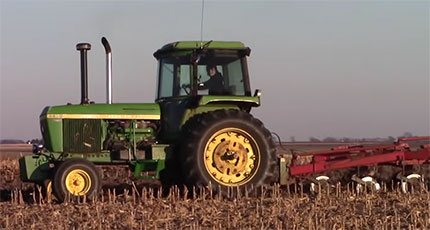The John Deere 4230 reviews talk about one of the most ambitious endeavors of the tractor brand.
Before the 4230 model came into the story, John Deere’s most popular model was the 4020 tractor. Then, to make adjustments and upgrades, John Deere introduced a revolutionary row-crop tractor that would change the tractor industry forever.
If you want to learn about the specs, information, and critical features of the John Deere 4230 tractor, stay tuned!
Key Notes:
- The John Deere 4230 tractor can drastically cut down farm hours in half with its numerous features that offer optimal results.
- The 4020 tractors were successfully replaced by the 4230 tractors by including better comfort, clearance, and visibility level.
- This tractor offers three types of transmissions.
Table of Contents
The History of John Deere 4230
The John Deere 4230 tractor is a part of Generation II series, manufactured in Waterloo, Iowa, USA, from 1973 to 1977.
Initially, the John Deere 4230 tractor was built to replace the 4020-the most popular tractor series by John Deere. In 1967, JD company gave the order to manufacture a new series of tractors that would surpass the previous version. However, the task seemed impossible at the time.
The 4020 tractor was considered the greatest tractor at the time of production. With reliability on the one hand and robust design on another, the 4020 made it seem like there was no one better. Along with the 4010, these tractors were economical and versatile.
With the production of Generation 2 tractors, the John Deere company prioritized safety. As a result, although the overall visual appearance of the new tractors was significantly modernized, the operator comfort was also upgraded.
The John Deere 4230 tractor offers a variation. You can get the tractor with a tricycle set that was most popular among row-crop tractors. Unfortunately, tricycle tractors were the leading cause of rollover accidents. John Deere did not want any bad publicity regarding the safety of their tractors.
Therefore, the rollover safety system was first tested with the 720 tractors and later with the Generation 2 tractors. As a result, the brand developed Roll-Guard in 1966, which will, later on, change the row-crop tractor factory for the best!

John Deere 4230 Tractor Variations
The John Deere 4230 tractor was available in row-crop, hi-crop, standard and low-profile variations. At the time, the 4230 offered more configurations than its competitors.
1. Standard Tractors
The standard tractors were a bit bigger than the row-crop version and included a particular set of wheels and an axle option.
Both the standard and the row-crop John Deere tractor offered the option of a Sound Gard Cab, open station, and four post-Roll-Gard.
The Sound Gard was not available for the hi-crop version of the 4230, with the risk of making it heavier. The low-profile version was the only one available with an open station.
2. Low-Profile
The John Deere 4230 low-profile tractor version was introduced in 1972.
This model was a true expert for groves, orchards, and other tasks. The tractor offered a low center of gravity with an open operator station and plenty of clearance overhead.
The tractor featured a non-telescopic steering wheel, modified fenders, and an adjustable or fixed axle option.
Although all three transmissions were available with this version, many tractors were equipped with a Power Shift.
3. Hi-Crop
The high-crop tractors were easily considered the most popular from the series. Just like with the low-profile tractors, the hi-crop version was available with all.
Three transmissions and included a wide or a narrow three-point hitch.
4. Row-Crop
The row-crop tractors were the only ones sold with a gasoline engine. The row-crop varieties offered convertible front-end options, which allowed the Roll-O-Matic to use double wheels or a single front wheel to mount to the tractor. The row-crop tractor also provided a narrow, wide, and regular front end instead of the convertible.
Further improvements were made with the John Deere 4230 tractors, such as a personal posture seat, which was available only in the Sound Gard body. In addition, the cloth which covered the seat offered great comfort for the operator, while the controls were easy to reach and use.
Lastly, all versions are available with the Quad-range, power-shift transmission, or Syncro-range transmission. So depending on your farming needs, it’s relatively easy to pick the appropriate John Deere type.
Key Specifications
| Manufacturer | John Deere |
| Type | Row-crop, standard, hi-crop, low-profile |
| Factory | Waterloo, Iowa, USA |
| Fuel tank capacity | 140 L |
| Battery | 6V x 2 |
| Cabin type | Open operator station. Four-post ROPS or Cab, Sound-Gard cab with air-conditioning optional. |
| Brakes | differential hydraulic wet disc brakes |
John Deere 4230: Engine

The John Deere engine is truly a masterpiece with the 4230 model.
The John Deere 4230 tractor has two engine choices: gas and diesel. The low fuel consumption is guaranteed because both engine options are liquid-cooled.
Gas engine: the gasoline engine was available only with the row-crop tractors. Those who purchased the gasoline engine tractor did not get to use the Sound Gard body. There are 33 4230 tractors built with a gasoline engine, making them a less popular version than the diesel engine.
Diesel engine: the diesel engine in the 4230 tractors is a liquid-cooled, 6-cylinder engine with a 6.6 L displacement.
The diesel and the gas engines produce a maximum power output of 100 HP.
Engine
| Engine type | Four-stroke, liquid-cooled, inline |
| Number of cylinders | 6 |
| Displacement | 6.6L |
| Bore and stroke | 4.25×4.75 inches |
| Compression ratio | 16.2:1 |
| RPM | 2200 |
| Starter volts | 12 |
| Oil capacity | 16.1L |
| Coolant capacity | 22.7 L |
| Firing order | 1-5-3-6-2-4 |
John Deere 4230: Transmission
In addition to the larger equipment of the tractor, John Deere needs to improve the transmission of the new model.
The 4230 model offered a partial power shift Quad-Range transmission with 16 forward and six reverse speeds.
The power shift transmission offered eight forward and four reverse speeds, while the Syncro range transmission offered eight forward and two reverse speeds.
The Syncro range transmission also featured a two-speed planetary unit and four forward speeds installed in each range.
One of the most significant upgrades for the John Deere 4230 tractor was the “creeper transmission.” The creeper transmission offered a manually operated planetary unit installed in the front of the Syncro-range transmission. Initially, the creeper transmission offered five extra slow ground speeds, perfect for operators using PTO-driven equipment.
The creeper transmission was extremely rare and was available from the beginning of 1974.
Transmission
| Chassis | 4×2 2WD or 4×4 HFWD 4WD |
| Steering type | Power steering |
| Brakes | Differential hydraulic wet disc |
Quad-Range Transmission
| Transmission type | Partial power shift and synchronized with wet disc clutch |
| Gears | 16 forward; 6 reverse |
| Wet disc oil capacity | 60.6 L |
Power-Shift
| Transmission type | Full power shift with wet disc clutch |
| Gears | 8 forward; 4 reverse |
| Wet disc oil capacity | 58.7 L |
John Deere Syncro-Range Transmission
| Transmission type | Partially synchronized |
| Gears | 8 forward; 2 reverse |
| Transmission oil capacity | 60.6 L |
John Deere 4230: Hydraulics, PTO & Dimensions
The John Deere 4230 tractor was the last line built with a tricycle option. As we mentioned, the tricycle option was popular among row-crop farmers. In addition, the tractor offered numerous front-end loader options.
In addition to front-end loaders, the tractor also offered rear-end options. The rear-end options came in long, extra-long, and unique long axle variations, as well as tire sizes that ranged from 15.5-38 to 21.1-30.
The 4230 tractors also offered dual rear wheels, while the other options included:
- A three-point hitch.
- Hydraulic front wheel assist.
- Power-weight transfer hitch.
- Wide swing drawbar.
- Various weight packages.
PTO
| Drawbar power | 86 horsepower |
| PTO | 100 horsepower |
| Independent rear rpm PTO | 540/1000 |
Dimensions
| Wheelbase | 104 inches |
| Width (widest point) | 89.625 inches |
| Cab width | 54.375 inches |
| Hood full height | 109.875 inches |
| Exhaust full height | 151.75 inches |
| Shipping weight | 8,100 lbs |
| Operating weight | 10,800 lbs |
| Fully ballasted weight | 14,150 lbs |
Tires
| AG front | 11.00×16 9.5L-15 6.00-16 7.50-16 10.00-16 7.50-20 (Hi-Crop) |
| AG rear | 18.4-26 23.1-26 16.9-34 18.4-38 13.6-38 15.5-38 16.9-38 18.4-38 20.8-34 |
John Deere 148 Loader
| Loader weight | 1350 lbs |
| Height | 126 inches |
| Dumped bucket clearance | 102 inches |
| Dump reach | 32 inches |
| Dump Angle | 38° |
| Level bucket clearance | 121 inches |
| Breakout force | 4700 lbs |
| Lift to full height | 3100 lbs |
| Bucket capacity | 0.5 cu yd 0.6 cu yd 0.8 cu yd 0.9 cu yd |
| Bucket width | 60 inches 72 inches 84 inches 96 inches |
John Deere 158 Loader
| Loader weight | 1771 lbs |
| Height | 156 inches |
| Dumped bucket clearance | 132 inches |
| Dump reach | 32 inches |
| Dump angle | 37° |
| Level bucket clearance | 151 inches |
| Breakout force | 5000 lbs |
| Lift to full height | 3800 lbs |
| Bucket capacity | 0.5 cu yd 0.6 cu yd 0.8 cu yd 0.9 cu yd |
| Bucket width | 60 inches 72 inches 84 inches 96 inches |
Common Issues With John Deere 4230 Tractor

The John Deere 4230 tractor is a piece of remarkable machinery. However, it does have a few flaws. After all, the 4230 tractors are over 40 years old and way past the modern technology of tractors.
Many users found that the tractor works marvelously in the summer. However, wintertime can be an enemy to the 4230 tractors. But, using a block heater will solve this issue.
The fuel consumption is not as optimal as the rest of the mid-range models, but this is a great tractor! As the horsepower rating is 100 HP, fuel efficiency is expected.
The AC in the cab could be better. During the summer months, it takes time to cool down the cab. However, if the AC is your biggest concern, you should check out the 4040 version instead.
FAQs
Does a John Deere 4230 have a turbo?
No, the John Deere 4230 tractor does not have a turbo, but users can add a turbo to the tractor.
Is a John Deere 4230 a good tractor?
Yes, the John Deere 4230 is a good tractor that comes in different variations for different farming tasks. In addition, the John Deere 4230 tractor offers three transmissions and more power than the previous series.
Nowadays, the 4230 can be reasonably priced and in good shape.
What engine is in a 4230 John Deere?
The John Deere 4230 tractor uses a six-cylinder, liquid-cooled diesel engine.
How much can a John Deere 4230 lift?
The John Deere 4230 tractor can lift 2194 lbs with a John Deere 400CX (MSL) Loader.
What horsepower is a 4230 John Deere?
The total horsepower of the 4230 John Deere tractor is 100 HP.
John Deere 4230 vs. 4020: Which model is better?
The John Deere 4230 tractor is better than the 4020 tractors. Due to the partial power shift quad-range transmission, wet clutch, and better hydraulic pump.
Conclusion
The 4230 remains one of the most popular John Deere tractors even after a few decades! This tractor is reliable and powerful and offers exquisite comfort for the operator.
These are all the crucial pieces of information you must know before you buy or sell your John Deere 4230 tractor. We hope you enjoyed it!
